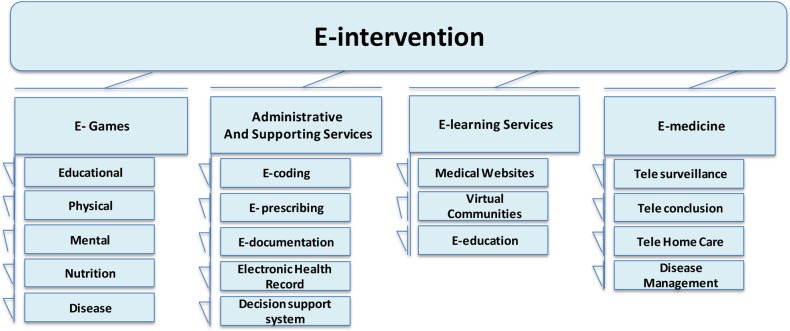Dear Editor-in-Chief
Electronic Health (E-health) is referred to any communication technology, which could have impact on behavior change, physical activity, and dieting (1). One of the E-health tools is electronic intervention (E-intervention) that means treatment, prevention, management, and physical and mental health promotion with or without the support of human (2), which finally leads to promotion of healthy behaviors and reduction of health problems. The application of E-intervention in healthcare is divided into four areas (Fig. 1).
Fig. 1:
Application areas of E-intervention in healthcare
As shown in Table 1, these interventions have significant impact in reducing costs and medical errors, increasing efficiency of health services and quality of care, improving the registration, storage, and retrieval system, facilitating healthcare information sharing between the patient and the treatment team, and promoting knowledge through the accessibility of resources and useful information to optimize decision making (1, 3–8).
Table 1:
The impacts of E-interventions based on reviewed studies
| Application area | Studies reviewed | Study results |
|---|---|---|
| E-game |
|
|
| E-medicine |
|
|
| administrative and supporting services |
|
|
| E-learning services |
|
|
The most effective interventions are E-games due to their attractiveness and entertainment for the users for improving knowledge and skills to solve the problems related to health care (2). This technology first created by Joyboard in 1982 has multiple applications in educational, physical, psychological, nutritional, and disease areas. Healthcare companies are also becoming active in the E-games market and offer a series of E-games for teaching children to eat healthier foods and increase physical activity. For example, cancer fighting games for teens worldwide has been demonstrated to empower teens in their battles with cancer and other games to help prevent obesity and manage childhood diabetes (9).
The benefits of E-games in healthcare are positive changes in healthy behaviors, disease prevention, diagnosis, treatment, promotion of awareness about risk factors, and Improvement in the quality of life (1). In fact, E-games by offering educational tips can be effective on promoting public health. Finally, there are three functional requirements for the implementation of E-game in healthcare that include development of an appropriate systems and tools, assessment of the interaction with users, and establishment of cognitive behavior indicators (10).
Acknowledgements
The authors declare that there is no conflict of interest.
Reference
- 1. Catwell L, Sheikh A. (2009). Evaluating eHealth Interventions: The Need for Continuous Systemic Evaluation. PLoS Med, 6( 8): e1000126. [DOI] [PMC free article] [PubMed] [Google Scholar]
- 2. Graham ML, Uesugi KH, Niederdeppe J, Gay GK, Olson CM. (2014). The Theory, Development, and Implementation of an e-Intervention to Prevent Excessive Gestational Weight Gain: e-Moms Roc. Telemed J E Health, 20 ( 12): 1135–42. [DOI] [PMC free article] [PubMed] [Google Scholar]
- 3. Graafland M, Ten Cate O, van Seventer JP, Schraagen JM, Schijven MP. (2015). Mapping the Demand for Serious Games in Postgraduate Medical Education Using the Entrustable Professional Activities Framework. Games Health J, 4( 5): 381–6. [DOI] [PubMed] [Google Scholar]
- 4. Koch C, Buice MA. (2015). A Biological Imitation Game. Cell, 163( 2): 277–80. [DOI] [PubMed] [Google Scholar]
- 5. Baranowski T, Blumberg F, Buday R, DeSmet A, Fiellin LE, Green CS, et al. (2015). Games for Health for Children-Current Status and Needed Research. Games Health J, 5( 1): 1–12. [DOI] [PMC free article] [PubMed] [Google Scholar]
- 6. Singh J, Badr MS, Diebert W, Epstein L, Hwang D, Karres V, et al. (2015). American Academy of Sleep Medicine (AASM) Position Paper for the Use of Telemedicine for the Diagnosis and Treatment of Sleep Disorders. J Clin Sleep Med, 11( 10): 1187–98. [DOI] [PMC free article] [PubMed] [Google Scholar]
- 7. Ajami S, Sarbaz M. (2014). The necessity of the use of mobile and wireless communications systems in hospital disasters. Health Information Management, 11(6): 665–6. In Persian. [Google Scholar]
- 8. Jahangiry L, Shojaeizadeh D, Abbasalizad-Farhangi M, Yaseri M, Mohammad K, Najafi M, et al. (2015). Interactive web-based lifestyle intervention and metabolic syndrome: findings from the Red Ruby (a randomized controlled trial). Trials, 16: 418. [DOI] [PMC free article] [PubMed] [Google Scholar]
- 9. Donner A, Goldstein D, Loughran L. (2008). Health e-Games Market Report: Status and Opportunities. San Francisco, CA : : Physic Ventures ; [Google Scholar]
- 10. Aresti-Bartolome N, Garcia-Zapirain B. (2015). Cognitive rehabilitation system for children with autism spectrum disorder using serious games: A pilot study. Biomed Mater Eng, 26 Suppl 1 : S811 – 24. [DOI] [PubMed] [Google Scholar]



